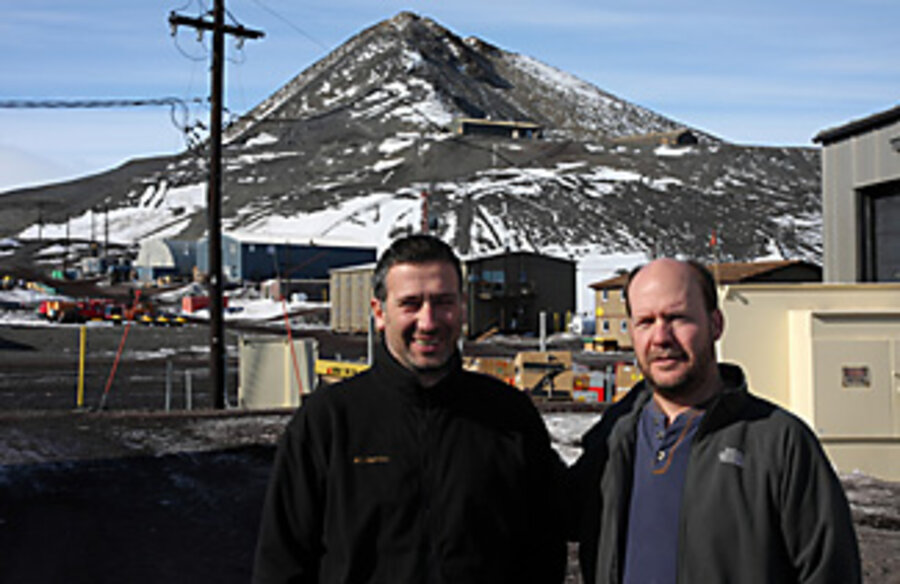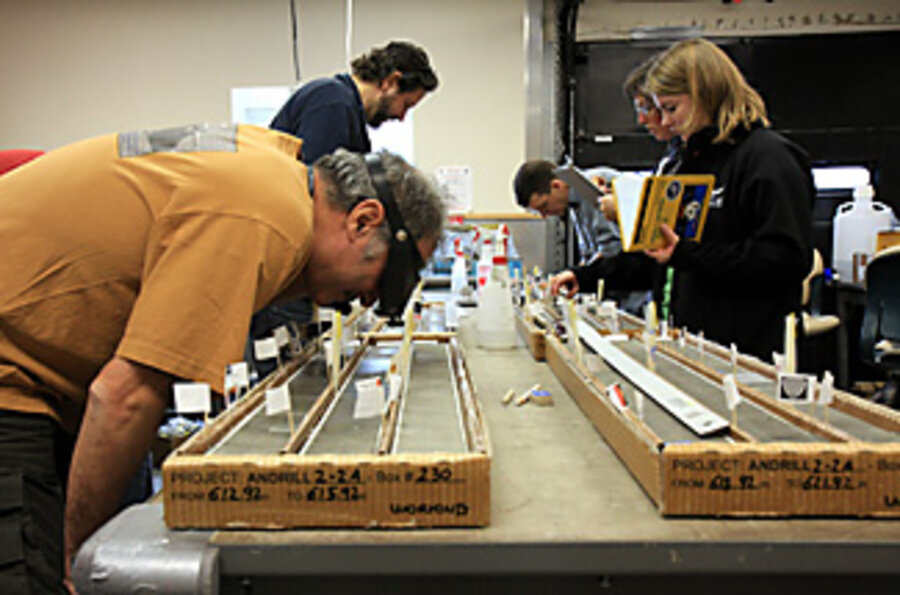Scientists read Antarctic mud for climate change insight
Loading...
| McMurdo Station, Antarctica
With summers both intense and ephemeral, life here is a race against the revolving seasons. Summer daylight never ceases at this US research base on Ross Island, just off the coast of Antarctica. The sun runs endless laps around the sky, and for those who live here, work never stops.
This blending of day and night centers on the 24-hour stratigraphy lab. Inside the nondescript metal building perched on stilts, geologists from around the world indulge, of all things, their collective love of petrified mud. Two shifts of scientists work around the clock examining a 4-inch-wide column of stone – a new section of which is delivered daily from a drill that, by the end of the season, will have penetrated three-quarters of a mile into the ocean bed.
This stone began as mud that settled on the ocean floor and curdled over eons into rock. From it, the scientists are reading geologic tea leaves between 14 million and 19 million years old: fossils and chemical signatures that provide a record of past climates – and show how Antarctica's ice sheets responded to climate swings.
In doing so, they hope to predict how well Antarctica's ice will withstand rising temperatures in the century to come.
•••
The two crews of scientists converge at 8:30 each morning: One has worked all night beneath the hum of fluorescent lights, and the other has just risen to pick up where the vampires left off.
Their one-hour meeting consists of a slide show of discoveries made overnight – worms petrified in million-year death throes, fossilized sea-shells, microscopic diatoms, and bits of gravel – all suspended in the core.
The slide show is lively, punctuated by questions and murmurs of surprise. "Here is something very weird," announces one presenter, "a bryozoan having some sort of affair with a foram." He points out two tiny fossils caught for eternity in a compromising interspecies pose. A nerdy joke – but the audience likes it.
After seeing slides, the crowd pours down the hallway for another daily ritual – the "land grab." They browse over tables where sections of last night's core lay end to end. Anywhere the gawkers find something they want to study in detail, they jam a toothpick with a paper flag into the cardboard case that cradles the core. The flags carry labels to identify the owners. "Pmag-ers do it better," say some of the flags – a cryptic boast to the consummate hipness of paleomagnetists who study the magnetic signatures of ancient rocks. Other flags sport the face of a lion; worms and snails were the lions of the mud, explains their owner, who searches the core for fossils of the predatory vermin.
Technicians will saw apart the core and deliver pieces to those who staked a claim.
The process repeats daily for eight weeks during the Antarctic summer. Each day offers surprises – and monotony. Science, like the seafloor, is sedimentary. Those fossils and diatoms aren't breakthroughs in themselves, but patient study of them gradually reveals a picture of the past.
A similar core drilled last year has already revealed surprises: the Ross Ice Shelf, a Spain-sized slab of ice that hangs off Antarctica's coast, has responded strongly to past climate shifts.
"We saw something like 50 cycles [in a few million years] of the Ross Ice Shelf disappearing and coming back," says Fabio Florindo, a soft-spoken geologist from the National Institute of Geophysics and Volcanology in Rome. He oversees work here, part of the Antarctic Drilling Project (ANDRILL), along with David Harwood, a micropaleontologist from the University of Nebraska in Lincoln.
The team must rush to finish its work. Fifteen miles from McMurdo, the drill rig rumbles atop 28 feet of floating ice. Its shaft churns through the ice and then 1,300 feet of seawater below to reach the seabed, where it gradually chews a 3,600-foot hole. Drillers must extract that entire section of core within eight weeks – while the weather is warm enough for outdoor work, but before summer temperatures make the ice too slushy to support the 40-ton drill rig.
The drill turns 24/7, as do the two shifts of geologists analyzing each day's core, 90 feet of which is delivered by helicopter at 10 p.m.
•••
At 2 a.m. sunlight streams horizontally through the windows of the core lab. Christopher Fielding, the University of Nebraska geologist who heads the vampire shift here, motions toward a section of core that alternates paper-thin layers of gray and white stone – layers of mud that solidified long ago. "We've had a lot of nice things to look at," he says, "but this is particularly nice."
When these mud layers formed, Antarctica must have had less ice than it does now – otherwise such delicate layers would have been scrambled by the piles of stones that coastal glaciers dump into the sea. They represent only a short chapter – a few thousand years out of millions – but they're sure to provoke "a feeding frenzy" in the morning, says Dr. Fielding, as people debate how to study them further.
One table over, another section of tonight's core traverses a different period of history. Pebbles lay suspended like chunks of fruit in a Jell-O salad, trapped in the gray background of the core exactly where they fell into the mud millions of years ago.
Sonia Sandroni, from the University of Siena in Italy, leans over the table like a student taking an exam, drawing each stone on a pad of paper with a handful of colored pencils.
"Every single stone is recorded in color," says Fielding. "She's up to about 60,000 so far."
The color Dr. Sandroni chooses for each pebble signifies the type of rock: red for granite, blue for sandstone, white for pumice, and so on. These rocks traveled to the ocean inside glaciers and icebergs, and by matching them to rocks in different parts of present-day Antarctica, she can tell where the rocks came from.
It's fascinating to watch her draw stone number 60,001 in red – not just the science, but also the sheer monotony with which discovery unfolds. Sandroni, undeterred, has already tuned out the conversation.
Just then Sandra Passchier, a sedimentologist from Montclair State University in New Jersey, points out something special in another section: embedded in stone, two conjoined circles of white, each the size of a pencil eraser. They are the cross section of a fossil shell called a foram.
"They're single-celled organisms related to amoebas," she says. "They have these little feet that they stick out of their shell to feed."
"I haven't seen any that big before," says Fielding as he gazes at the wonder. It's a single cell large enough to see – a Neanderthal amoeba.
These surprises are part of the fun of looking at cores. A core is a blind stab into the past: a four-inch aperture through which to view an entire epoch of history. That narrow gaze is sure to overlook some prizes – like a rare specimen that the drill misses an inch to the left.
But then come moments of serendipity, says Fielding: "You're always surprised when you find a large, well-preserved fossil. The chances of hitting a complete mollusk in a four-inch cylinder drilled into the seafloor are pretty slim. And we've had some beautiful fossils."
Each fossil presents an opportunity; not a eureka moment, but at least a chance to reconstruct an ancient environment by identifying the species that lived there.
The process begins in Antarctica at 2 in the morning, and will continue as pieces of the core are picked apart, in labs around the world, for years to come.






